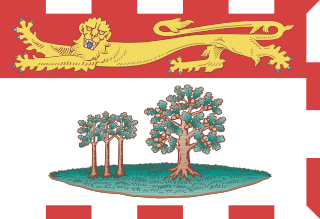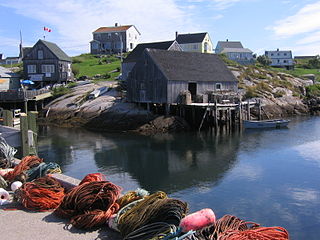
The Maritimes, also called the Maritime provinces or the Canadian Maritimes, is a region of Eastern Canada consisting of three provinces: New Brunswick, Nova Scotia, and Prince Edward Island (PEI). The Maritimes had a population of 1,813,606 in 2016. Together with Canada's easternmost province, Newfoundland and Labrador, the Maritime provinces make up the region of Atlantic Canada.

The Charlottetown Conference was held in Charlottetown, Prince Edward Island for representatives from the colonies of British North America to discuss Canadian Confederation. The conference took place between September 1 through 9, 1864.

Events from the year 1873 in Canada.

Events from the year 1866 in Canada.

The Prince Edward Island Liberal Party is a political party in the province of Prince Edward Island, Canada. The PEI Liberals are affiliated with the federal Liberal Party of Canada. The party is led by Premier Wade MacLauchlan, a former president of the University of Prince Edward Island.

James Colledge Pope, was a land proprietor and politician on Prince Edward Island (PEI), Canada. He served as premier of the colony from 1865 to 1867, and from 1870 to 1872. He was premier of PEI in 1873 when the island joined Canadian confederation.

Robert Poore Haythorne was a Prince Edward Island politician and premier. He was born in England to a prominent family, his father having been mayor of Bristol on several occasions.
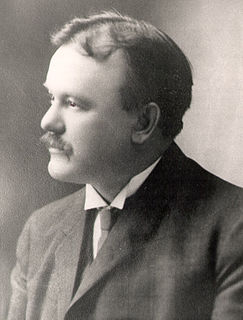
John Alexander Mathieson was a Prince Edward Island politician and jurist, the 12th Premier.
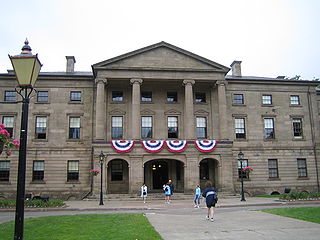
The Legislative Assembly of Prince Edward Island, along with the Queen of Canada in Right of Prince Edward Island, represented by the Lieutenant-Governor of Prince Edward Island, forms the parliament of the province. The General Assembly meets at Province House, which is located at the intersection of Richmond and Great George Streets in Charlottetown.

The Lieutenant Governor of Prince Edward Island is the viceregal representative in Prince Edward Island of the Canadian monarch, Queen Elizabeth II, who operates distinctly within the province but is also shared equally with the ten other jurisdictions of Canada, as well as the other Commonwealth realms and any subdivisions thereof, and resides predominantly in her oldest realm, the United Kingdom. The Lieutenant Governor of Prince Edward Island is appointed in the same manner as the other provincial viceroys in Canada and is similarly tasked with carrying out most of the monarch's constitutional and ceremonial duties.
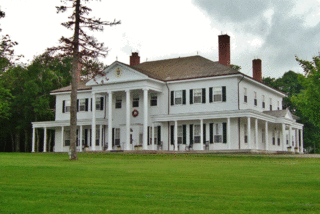
Government House of Prince Edward Island, often referred to as Fanningbank, is the official residence of the Lieutenant Governor of Prince Edward Island, as well as that in Charlottetown of the Canadian monarch. It stands in the provincial capital at 1 Terry Fox Drive; while the equivalent building in many provinces has a prominent, central place in the capital, the site of Prince Edward Island's Government House is relatively unobtrusive within Charlottetown, giving it more the character of a private home.
The politics of Prince Edward Island are centred on a provincial government resembling that of the other Canadian provinces. The capital of the province of Prince Edward Island is Charlottetown, where reside the premier, provincial legislature, lieutenant-governor and cabinet.

By the arrangements of the Canadian federation, the Canadian monarchy operates in Prince Edward Island as the core of the province's Westminster-style parliamentary democracy. As such, the Crown within Prince Edward Island's jurisdiction is referred to as the Crown in Right of Prince Edward Island, Her Majesty in Right of Prince Edward Island, or the Queen in Right of Prince Edward Island. The Constitution Act, 1867, however, leaves many royal duties in Prince Edward Island specifically assigned to the sovereign's viceroy, the Lieutenant Governor of Prince Edward Island, whose direct participation in governance is limited by the conventional stipulations of constitutional monarchy.
Prince Edward Island is a Canadian province consisting of an island of the same name. The island is part of Mi'kma'ki, the lands of the Mi'kmaq people. Explored by Europeans in the 16th Century, the French claimed all of the lands of the Maritimes in 1604 and French colonists arrived in 1720. By conquest, the British claimed all of the lands including Prince Edward Island in 1763. It became the British colony of St. John Island in 1769 and joined the Canadian Confederation on July 1, 1873.
The 13th General Assembly of Prince Edward Island represented the colony of Prince Edward Island between February 3, 1831, and 1835.
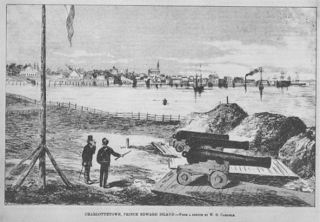
The History of Charlottetown can be traced back to the original French military settlement established on the site in 1720. Over the years it has grown to become the largest and most important city on Prince Edward Island.
